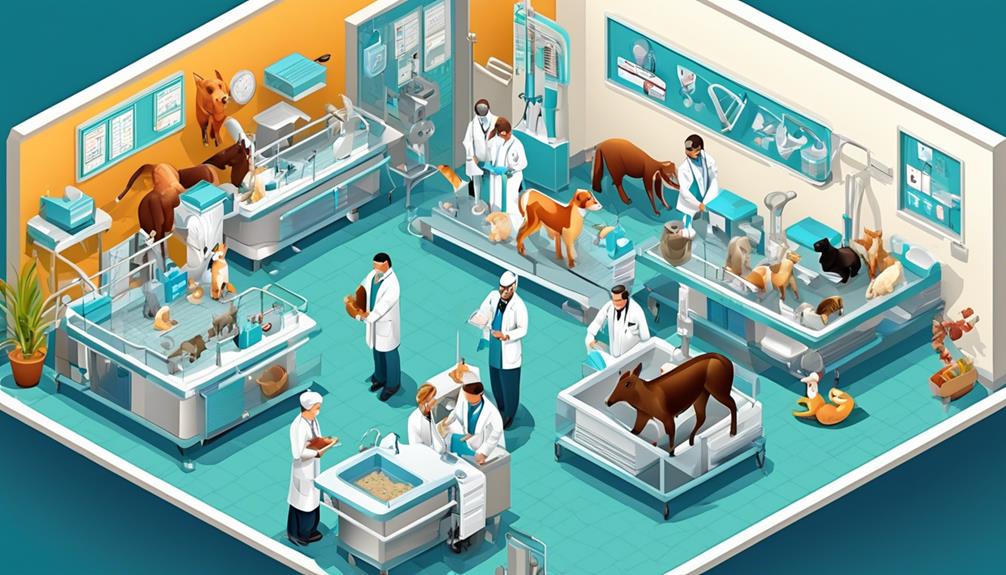As of the most recent data, there are a total of 124,069 veterinarians in the U.S., with 31,194 for whom no information is available.
The field of veterinary medicine is more diverse and dynamic than one might initially assume. From the latest trends in pet ownership to the various specializations and demographics within the veterinary profession, the statistics offer a fascinating glimpse into this vital and evolving industry.
Key Takeaways
- The total number of veterinarians in the U.S. is 124,069, with 31,194 veterinarians having no available information.
- The median annual wage for veterinarians is $103,260.
- Employment in the veterinary field is projected to grow by 20% from 2022 to 2032.
- Veterinarians can specialize in various areas such as internal medicine, surgery, dentistry, dermatology, ophthalmology, cardiology, oncology, neurology, radiology, and more.
Total Number of Veterinarians
The total number of veterinarians in the United States is 124,069, encompassing active AVMA members and nonmembers born after 1952 who obtained their veterinary degree after 1978. This figure represents a significant workforce dedicated to animal health and welfare.
It's important to note that this data is available for the years 2013-2021, allowing for an understanding of trends and developments within the veterinary profession.
The median annual wage for veterinarians was $103,260 in May 2022, with variations based on factors such as experience, location, and specialization.
Looking to the future, employment of veterinarians is projected to grow by 20% from 2022 to 2032, reflecting the increasing importance of pets and livestock in society, as well as the crucial roles played by veterinarians in public health, food safety, and research.
Additionally, the demographics of the veterinary workforce reveal that 62.9% of veterinarians are women, and there are income disparities across different races and ethnicities, highlighting areas for further study and improvement in the profession.
Veterinary Specializations

With the increasing demand for specialized care in animal health, veterinarians can pursue a wide range of veterinary specializations to address specific health and wellness concerns in animals. These specializations encompass diverse areas such as internal medicine, surgery, dentistry, dermatology, and ophthalmology.
Additionally, veterinarians can specialize in fields like cardiology, oncology, neurology, radiology, and emergency and critical care to provide specialized care for animals with complex medical needs. Specializations also include veterinary pathology, clinical nutrition, behavior, anesthesia, and preventive medicine to address specific health and wellness concerns in animals.
Furthermore, veterinarians can specialize in areas such as zoological medicine, wildlife rehabilitation, sports medicine and rehabilitation, and integrative medicine for comprehensive animal care. Moreover, veterinary specializations extend to areas like theriogenology (reproductive medicine), veterinary toxicology, public health, and veterinary forensic science to address diverse animal health and welfare issues.
As the demand for specialized veterinary care continues to grow, these specializations play a crucial role in ensuring the health and well-being of a wide variety of animals.
U.S. Pet Ownership Statistics
As a veterinarian, I encounter a wide array of pet ownership statistics in the United States, shedding light on the diverse landscape of companion and exotic animals in our society. These statistics not only reflect the profound bond between humans and animals but also provide valuable insights into the evolving role of pets in our lives.
Here are some key U.S. pet ownership statistics:
- Approximately 67% of U.S. households own at least one pet, showcasing the significant prevalence of animals in our homes and families.
- Dogs are the most popular pets, with nearly 63 million households owning at least one, highlighting their enduring status as beloved companions.
- Cats follow closely behind, with around 42 million households opening their doors to these independent and affectionate felines, emphasizing their widespread appeal.
- The increasing trend of exotic pet ownership is evident, with an estimated 13 million households embracing non-traditional pets, reflecting our growing fascination with unique and diverse animal companions.
These statistics underscore the profound impact that pets have on our lives, reaffirming the importance of compassionate and expert veterinary care for all our beloved animal friends.
Occupational Outlook for Veterinarians

Navigating the occupational landscape as a veterinarian presents a myriad of opportunities and challenges in today's dynamic and evolving society. The median annual wage for veterinarians was $103,260 in May 2022, varying based on experience, location, and specialization.
Employment of veterinarians is projected to grow 20 percent from 2022 to 2032, driven by the increasing importance of pets and livestock in people's lives, as well as opportunities in public health, food safety, and research.
To practice, veterinarians must have a Doctor of Veterinary Medicine degree from an accredited veterinary college and a state license, with admission to veterinary programs being competitive. Most veterinarians work in private clinics and hospitals, while others may work in various settings related to food safety, inspection, or research, providing diverse work environments and earning potentials.
Understanding the economic landscape of the veterinary profession is essential, and data on U.S. veterinarians, including gender statistics, pet ownership trends, and workforce demographics, can provide valuable information for decision-making.
The veterinary profession offers promising growth and diverse career paths, making it an exciting field to enter.
Economic Reports and Market Research Data
The economic reports and market research data offer valuable insights into the veterinary profession. They provide information on pet ownership trends, workforce demographics, and the overall economic landscape.
The data reveals pet ownership trends. This information helps us understand the evolving needs of pet owners and the demand for veterinary services. Ultimately, it impacts the veterinary industry's growth and development.
Market research data provides crucial information on the demographics of veterinarians. It sheds light on gender statistics, pay gaps, and race and ethnicity demographics. This information is essential for ensuring equity and diversity within the veterinary profession.
Understanding the economic landscape through these reports is vital for making informed decisions and strategic planning within the veterinary field. It allows us to adapt to market factors and anticipate changes. This ensures the profession's sustainability and success.
AVMA membership data, U.S. pet ownership data, U.S. veterinarian data, and veterinary specialists data are indispensable components of market research. They enable us to identify trends, challenges, and opportunities for the veterinary profession.
These insights derived from economic reports and market research data are instrumental in shaping the future of veterinary medicine and enhancing the well-being of animals and their owners.
Veterinarian Demographics and Statistics

In 2021, the U.S. veterinary workforce comprised 124,069 veterinarians, encompassing diverse specializations and practice settings. Here are some key demographics and statistics about veterinarians in the U.S.:
| Statistics | Data |
|---|---|
| Total Veterinarians | 124,069 |
| Veterinarians with No Available Info | 31,194 |
| Median Annual Wage | $103,260 |
| Projected Job Growth (2022-2032) | 20% |
The U.S. veterinary workforce is composed of individuals with various board certifications from AVMA-recognized veterinary specialty organizations. They work in a wide range of settings, including private clinics, hospitals, farms, ranches, laboratories, classrooms, and zoos. Additionally, the job outlook for veterinarians is promising, with a projected 20% growth from 2022 to 2032. This growth is expected to create opportunities in areas such as public health, food safety, and research. Despite the challenges, the veterinary profession remains an essential and growing field with diverse opportunities for specialized practice and career advancement.
Foreign Languages Spoken by Veterinarians

As a reflection of the diverse composition of the veterinary workforce in the U.S., veterinarians proficiently communicate in a variety of foreign languages to serve a wide range of pet owners and to facilitate collaboration with international animal care and research professionals.
This multilingual capability is essential for ensuring effective communication and providing comprehensive care to pet owners from diverse cultural backgrounds. It also enables veterinarians to engage in global partnerships and exchange of knowledge to advance animal health and welfare worldwide.
The ability to speak foreign languages fosters trust and understanding between veterinarians and pet owners, leading to better compliance with treatment plans and improved health outcomes for animals. Additionally, it enhances the inclusivity of veterinary practices and contributes to the overall advancement of the veterinary profession.
Embracing linguistic diversity allows veterinarians to break down language barriers, promote cultural competence, and ultimately deliver better care for their animal patients.
Frequently Asked Questions
What Are the Most Common Health Issues That Veterinarians Encounter in Their Practice?
In my practice, I commonly encounter dental issues, skin conditions, ear infections, and gastrointestinal problems in pets. Livestock and farm animals often present with musculoskeletal injuries, infectious diseases, and reproductive issues. Additionally, zoonotic diseases are a concern.
How Do Veterinarians Stay up to Date With the Latest Advancements in Animal Healthcare?
I stay updated in animal healthcare through continuing education, conferences, self-learning, and collaborating with colleagues. Utilizing technology and professional organizations like AVMA, I access webinars, online courses, and research to enhance my knowledge base.
What Are the Typical Work Hours and Schedule for Veterinarians in Different Specialties?
As an emergency vet, I work non-traditional hours, often nights, weekends, and holidays. I provide round-the-clock care for sick and injured animals. It's demanding but rewarding to be there when animals need help the most.
Are There Any Specific Challenges or Ethical Dilemmas That Veterinarians Often Face in Their Profession?
Yes, veterinarians often face ethical dilemmas balancing animal welfare, client preferences, and financial limitations. Providing the best care while respecting clients' ability to pay, navigating end-of-life care decisions, and communicating effectively with pet owners.
Can Veterinarians Specialize in Working With Exotic or Non-Traditional Pets, and What Kind of Training Is Required for This Specialization?
Yes, veterinarians can specialize in exotic or non-traditional pets like reptiles and birds. They need to complete a residency program and become board-certified. Additional training in exotic animal care, diagnostics, surgery, and anesthesia is required.
Conclusion
In conclusion, the veterinary field is like a thriving garden, with blooming opportunities and a growing demand for skilled caregivers.
As the bond between humans and animals continues to strengthen, the need for compassionate veterinarians will only rise.
With a projected 20 percent growth in employment, the future looks bright for those with a passion for healing and caring for our furry friends.
So, grab your stethoscope and get ready to be part of this flourishing field!










